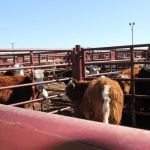Feeder cattle prices in Western Canada were $2 lower to $3 higher per hundredweight (cwt) last week, with many factors influencing the market.
In central Alberta, Simmental steers weighing 429 pounds sold for $191/cwt; Charolais-cross steers averaging 684 pounds sold for $151/cwt in the same region. Mixed exotic cross steers weighing 850 pounds traded at $137/cwt in east-central Saskatchewan.
While prices in Western Canada were relatively unchanged, the U.S. feeder market continued to surge higher with prices $5-$10/cwt above week-ago levels. The U.S. Department of Agriculture reported in Bassett, Neb., a load of 612-pound heifers sold for $212/cwt.
Read Also

U.S. livestock: Cattle fall sharply as Trump says he’s working to lower beef costs
Chicago cattle futures fell sharply on Friday after U.S. President Donald Trump said his administration was working to lower the…
It is now common to see steers in the range of 500 to 550 pounds sell over $200/cwt in the U.S. It is only a matter of time before these higher U.S. prices spill over into the western Canadian market. We should see larger Canadian feeder cattle exports given the current price structure.
The USDA report was negative for North American feedgrain prices as the Dec. 1 corn stocks were sharply higher than traders’ expectations. U.S. winter wheat acres were also higher than expected and world wheat fundamentals are extremely bearish. I’m expecting widespread wheat usage from Texas to central Alberta in the latter half of the crop year, lowering the cost per pound gain. These two factors added some dynamite to the U.S. feeder market, causing the futures to make all-time record highs.
U.S. producers are now in the expansionary process, which is causing feeder cattle supplies to be abnormally tight. Keep in mind that Texas producers who liquidated their herds back in July are also trying to get back to regular numbers. Look for Canadian feeder prices to move sharply higher over the next month to catch up to the U.S. market.















